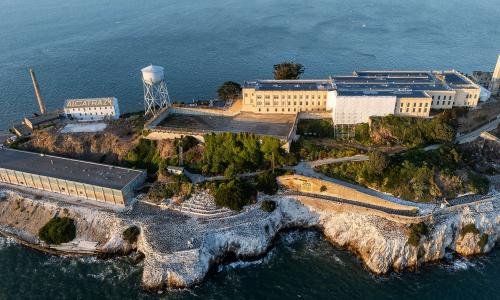The famous Alcatraz Island, known globally as “The Rock,” might soon return to the spotlight—not as a tourist destination, but as a fully functional federal facility. Former President Donald Trump is once again making headlines as several of his former officials visited the now-defunct prison, sparking fresh debate about his plan to reopen Alcatraz as part of a larger law-and-order campaign.
With its eerie silence, crumbling walls, and haunting past, Alcatraz has been a symbol of justice, punishment, and isolation. Now, it could become something much bigger—a new chapter in America’s criminal justice narrative.
Why Trump Wants to Reopen Alcatraz
The push to reopen Alcatraz is not entirely new. During his presidency, Trump hinted at ideas that involved strong federal responses to crime and civil unrest. However, his recent campaign trail statements and press briefings suggest a revived and more aggressive interest in bringing back “The Rock” as a symbol of zero tolerance.
According to Trump’s team, reopening Alcatraz would serve several purposes:
- Deterrence: A strict facility like Alcatraz could send a message to hardened criminals.
- National Security: High-risk federal prisoners could be kept in an isolated location.
- Symbolism: Reintroducing the notorious prison aligns with Trump’s narrative of being “tough on crime.”
“Criminals need to understand that we mean business,” Trump said during a recent rally. “Alcatraz was once the most feared prison in America. Maybe it’s time to bring that fear back.”
The Recent Tour: What Happened?
Earlier this week, a group of former Trump administration officials—including ex-Attorney General William Barr, Homeland Security advisor Tom Bossert, and a few unnamed consultants—toured the island under tight security. While the visit was labeled as “informational,” insiders suggest it was more than a casual sightseeing trip.
Photos show officials taking notes, inspecting infrastructure, and discussing logistics with National Park Service guides. Alcatraz currently operates as a historic site under the National Park Service, hosting over a million tourists annually. Converting it back into a federal prison would involve enormous legal, environmental, and financial challenges.
Still, their presence has fueled speculation that serious conversations are underway to revive the prison for modern use.
Public Reaction: Mixed and Loud
The idea to reopen Alcatraz has generated strong reactions from both supporters and critics.
Supporters Say:
- It Sends a Message: Tough prisons deter future crimes.
- Historic Use: Alcatraz was once used for the nation’s most dangerous criminals—why not again?
- Tourist Impact: The reopening could even boost tourism for those curious about modern vs. historical uses.
Critics Argue:
- Human Rights Concerns: Isolating prisoners on an island could violate ethical standards.
- Cost: Rebuilding and maintaining such a facility would require millions, if not billions, in federal spending.
- Environmental Impact: Alcatraz is now a protected site with historical and ecological importance.
“The idea of reopening Alcatraz as a working prison is absurd,” said San Francisco Supervisor Aaron Peskin. “It would undo decades of progress in historical preservation and criminal justice reform.”
A Brief History of Alcatraz

Before digging into whether reopening Alcatraz is even feasible, it’s worth revisiting its history.
- Opened as a federal prison in 1934, Alcatraz housed infamous inmates like Al Capone, George “Machine Gun” Kelly, and Robert Stroud, the “Birdman of Alcatraz.”
- Shut down in 1963 due to high operational costs and deteriorating infrastructure.
- Became part of the National Park Service in 1972 and is now a top tourist destination in San Francisco Bay.
The island’s isolation made it nearly escape-proof, which is part of the reason Trump and his advisors view it as ideal for high-risk offenders.
Legal and Logistical Hurdles
Reopening Alcatraz is far from a simple decision. Here are the major roadblocks:
1. Ownership and Status
Alcatraz is managed by the National Park Service. To convert it back into a prison, Congress would need to approve its transfer back to the Department of Justice or Bureau of Prisons.
2. Infrastructure
The prison has been out of use for over 60 years. Plumbing, electricity, and security systems are outdated or nonexistent. Retrofitting the entire island would cost an estimated $1.5 billion.
3. Environmental Regulations
Alcatraz Island is part of a protected marine ecosystem. Any construction would require strict adherence to environmental laws, especially those regarding protected bird species and native vegetation.
4. Public and State Opposition
California lawmakers are already voicing strong opposition. Governor Gavin Newsom released a statement saying:
“We will fight any attempt to turn Alcatraz into a symbol of regression rather than progress.”
Trump’s Crime Agenda: Political Context
The effort to reopen Alcatraz fits within Trump’s broader 2025 campaign message—”Restoring Order to America.” His campaign highlights growing urban crime rates, border security, and federal prosecution reforms. Reviving Alcatraz serves as both a literal and symbolic centerpiece for that platform.
Analysts believe this strategy resonates strongly with Trump’s base, who often prioritize law enforcement and strict justice policies.
“Alcatraz is not just a prison—it’s a message,” said political analyst Jordan Franks. “And Trump knows how to turn symbolism into votes.”
Could Alcatraz Really Be Used Again?

The reality is complicated. While it is technically possible to reopen Alcatraz, the political, legal, and practical barriers make it unlikely in the short term. However, the spectacle of suggesting it—as Trump often does—creates a national conversation and keeps the former president at the center of public discourse.
Some experts suggest the talk around Alcatraz may be more about political branding than actual policy.
“He may never reopen Alcatraz,” said Harvard Law professor Linda Reiss. “But by talking about it, he defines the political battlefield.”
What’s Next?
No official plan has been filed yet to reopen Alcatraz, but the recent tour signals more than just curiosity. As Trump continues to campaign on “law and order” in anticipation of the 2026 midterms and possibly the 2028 presidential race, expect the topic to surface again—especially in rallies, press interviews, and conservative media.
The National Park Service, for its part, remains neutral but cautious. “We are always open to discussions,” said a spokesperson, “but the island remains a protected site, and no changes are being considered at this time.”
Final Thoughts
The idea to reopen Alcatraz is powerful, emotional, and controversial. It touches on themes of justice, punishment, politics, and history—all wrapped up in one small island off the coast of San Francisco.
Whether or not “The Rock” becomes a working prison again, it’s clear that Trump and his allies are using the idea to energize a base that responds well to bold, dramatic proposals. For now, Alcatraz remains a tourist site, but its future is uncertain—as uncertain as the American criminal justice system itself in this highly politicized era.
Read Next – What Is a Stablecoin? House Passes Landmark Crypto Regulation Bills






